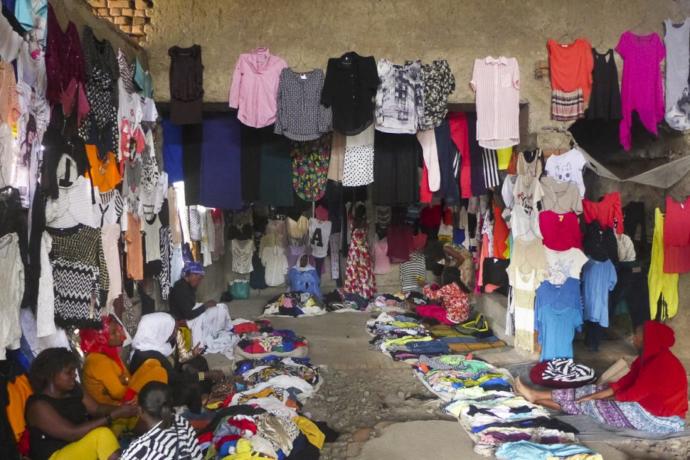Most people assume that when they donate clothes to a charity or thrift shop, they are donating them to those in need such as the homeless, and you'd be right a small percentage of the time, but your donations often go much further and do much more then you'd ever expect.
1.We throw out a lot

American's are wearing nearly 5x more clothing then we did a few decades ago and we're also tossing out much more of it because clothing, thanks in part to a grand marketing scheme, has become seasonal wear, as opposed to clothing you wear for a few years and toss out when they're truly damaged. As such, if we ever were to truly donate all of the clothes tossed out each day, shelters would be overwhelmed by the amount of clothing.
2. The crappy stuff gets a second life
If you wonder why anyone would donate clothing that is clearly too stained or ripped to wear by anyone, don't fret. You may be surprised to learn that your local thrift shop sells these pieces in bulk to both foreign and local companies to be used as literal rags for cleaning or it's ground up and used as insulation, for industrial needs, or carpet padding.
3. Brand name pieces are sorted and sold

A lucky few thrifters will stumble upon the creme de la creme of thrifting when they find a pair of unworn, unused Louis Vuitton's at their local thrift store for cheap, but a lot of shops will go through donations picking out these designer pieces and sell them directly to consignment shops or other second hand retailers in the US or abroad for profit.
4. About 10% of your donations are sold in shop
Just a scant 10% of what is brought in to charity shops is sold in store. These help give American's jobs, often those in dire straights themselves or with disabilities that may have prevented their employment elsewhere. The clothes in shop are then bought by those who may not be able to afford clothing otherwise or to those shopping to either re-sell quality items themselves through Ebay/Poshmark/Mercari/Etsy, etc, or just shopping for a really good bargain, or the true environmentalist who do not believe in contributing to landfill waste by constantly buying new clothing.
4. Foreign countries absorb the bulk of your clothing

In many third world countries, thrifting and selling thrifted clothes is a way of life. Manufacturing clothes from scratch is often too costly, manufacturing is lagging behind on a technological level, and many would never be able to afford new clothing. A vast majority of the clothing is sent to foreign buyers who sell your clothing at "bend over markets," aka, markets in the local communities where the clothes are laid out on the ground, where customers "bend over" and select what they want for cents on the dollar.
There is also a demand by many young people for American and other foreign designer clothing. Walking through many of these countries in the cities and universities, one might be surprised just how much American clothing is being worn. It's not just the stereotypical American rag clothing you see, but young people walking around in major brand labels and designer wear.
5. For profit donations only
Many places around the world, you will find donation bins alongside the road for you to conveniently donate your clothing, but a lot of these are for profit companies who do not donate any of your clothes to charitable organizations or the homeless. Again, a lot of your clothing is shipped abroad, picked through for the high quality which is sold as such, and the rest sent to bend over markets.
6. Thrift or landfill

Despite a lot of for profit deals going on with what you may have assumed was just going to charity alone, the truth still remains that without your donations, you are helping to attribute to 7% of the nations landfill waste by just tossing even your most beat up clothes into the trash. American's toss out about 70lbs of clothes each year, which is the equivalent to about 200 t-shirts! By donating your clothes, you are providing clothes for many other people who may not have otherwise been able to afford them and helping to contribute to a lot of foreign economies and communities that absolutely rely on your castoffs to help them make a living or afford basic clothing.
 Holidays
Holidays  Girl's Behavior
Girl's Behavior  Guy's Behavior
Guy's Behavior  Flirting
Flirting  Dating
Dating  Relationships
Relationships  Fashion & Beauty
Fashion & Beauty  Health & Fitness
Health & Fitness  Marriage & Weddings
Marriage & Weddings  Shopping & Gifts
Shopping & Gifts  Technology & Internet
Technology & Internet  Break Up & Divorce
Break Up & Divorce  Education & Career
Education & Career  Entertainment & Arts
Entertainment & Arts  Family & Friends
Family & Friends  Food & Beverage
Food & Beverage  Hobbies & Leisure
Hobbies & Leisure  Other
Other  Religion & Spirituality
Religion & Spirituality  Society & Politics
Society & Politics  Sports
Sports  Travel
Travel  Trending & News
Trending & News
Most Helpful Opinions